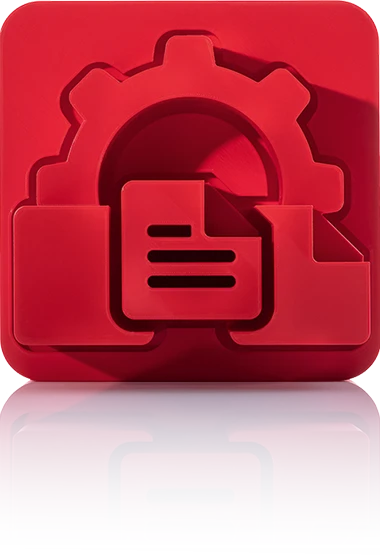Print Publishing
Automated Print Production with Adobe InDesign without Compromising on Design

Advantages of print publishing
Function Overview
Layout
Three flexibly combinable procedures are available for the layout:
Modular placement
This is used for pages with a modular layout. The elements are positioned automatically on the basis of a layout template. Displacement mechanisms can be used here. Common areas of application: catalogs and data sheets.
Floating placement
This is usually used for chapters with a uniform layout throughout. Based on a predefined layout template, a smooth break is created automatically. Common area of application: illustrated price lists.
Free placement
Objects can be positioned and formatted freely in InDesign. This procedure in the interaction between crossbase and Adobe InDesign is unique. Frequently used: decorative pages, editorial pages and brochures.
Editors
Table editor
Product tables are created in the table editor. From simple standard tables to complex matrix tables, all requirements are covered. Tables can contain features, product images, texts and prices. Adjustments to the table layout can also be saved back to the database for subsequent updates and language changes. To minimize the number of table templates, complex table layout rules are possible. These include dynamic column widths, functions for cell grouping and grouping rules.
Layout editor
Operation of the layout editor is based on the way Adobe InDesign works and is easy to learn. Scripting skills are not necessary. The crossbase layout editor offers a large number of pre-configured layout rules. With innovative functions such as displacement and pagination control, flexible layout templates can be created which can then be reused for similarly structured pages.
Pages
Page section planning
The page sections are created in a chapter-oriented publication structure that is independent of the product structure. Content can be assigned to a page either by linking products or images, texts and tables.
Page production and layout adjustments
For page production, the page documents and the production languages are selected in the page management. Fully automated production or price updates can then be started with a click of the mouse.
Data sheet engine
With the data sheet engine in combination with the template editor and the print server, masses of data sheets can be created for all articles in InDesign.
Fully automated data sheet production
With our automated data sheet production, you can create item-specific data sheets quickly and efficiently. Complete page sequences for entire assortments are created on the basis of sample data - ideal for thousands of items. Production is carried out using Adobe InDesign in various languages, with only changed content being updated. The finished, language-specific PDFs are assigned to the items and can be used in a variety of ways.
Correction process
The correction process can be carried out using the usual PDF correction tools. A language-specific PDF is generated for each page, in which overflows are highlighted in color. The correction process is supported by the traffic light system.
Creation of the Adobe InDesign book
Once all pages of a chapter have been created, they are combined into an Adobe InDesign book. Various book functions can be automated to create the complete document and the print-ready PDF.
Functions
Update
Placed content such as text and images can be subsequently updated with a click of the mouse. This means that all changes that have been made in the PIM in the meantime are adopted.
Search and selection
All images, texts or InDesign snippets (e.g. product tables from catalogs) can be selected from the crossbase database using a full-text search or structured search in trees. The selection is visually supported by previews with a zoom function. Metadata can also be queried.
Inserting and positioning
Click on the plus symbol to insert the selected element (image, text or snippet) into the document. If required, image data can be downloaded in low resolution to a local directory if access to the PIM database is temporarily unavailable during further processing of the document. Text formatting can also be taken into account.
Saving
The InDesign document is saved in the file directory. Any content in the document that was selected via the crossbase database retains the connection to the database. This means that it can be verified at any time where this content comes from. For this purpose, when content is placed in the InDesign document, a corresponding label is stored so that the references can be clearly identified and traced back to the source element in the crossbase database.
Adobe Plugins
It is not always the large product catalog that needs to be produced automatically using standardized layout templates. The InDesign plugin from crossbase is suitable for smaller projects. It integrates directly into the main menu of InDesign and makes the crossbase content available in a palette.
There is also the option of accessing content from the crossbase database for Photoshop via an integrated plugin.
Fully automated data sheet production
This allows you to create item-specific data sheets quickly and efficiently. Complete page sections for entire product ranges are created on the basis of sample data - ideal for thousands of articles. Production takes place via Adobe InDesign in various languages, whereby only changed content is updated. The finished, language-specific PDFs are assigned to the articles and can be used in a variety of ways.
Translate
Completed documents can be translated automatically. The texts and images in the source language are inserted in the desired foreign language. This is done automatically and congruently on the corresponding language levels. Paragraph formats that are assigned to the text frames in the main language also automatically apply to the translations so that the formatting is retained. The advantage of using language levels is that the foreign-language PDF can be saved by simply selecting the language levels.
Special features of the crossbase solution
Strict separation of layout and content in the crossbase database - changes do not affect each other.
Two-part layout structure: Layout consists of templates with placement rules and is organized separately from the content.
Linking of layout and content: Content (text, images) is linked to the layout templates via defined categories.
Automated production: Adobe InDesign page documents are created automatically based on the layout template.
Restoring the layout: Created page layouts are saved in the crossbase database.
Content changes are logged and can be quickly updated in the InDesign document.
Simple updates to new InDesign versions thanks to clear separation and automation.
I look forward to a personal consultation with you.
Call now +49 7031 9881-770
or send me a message
Herby Tessadri
Sales Manager and Authorized Signatory

